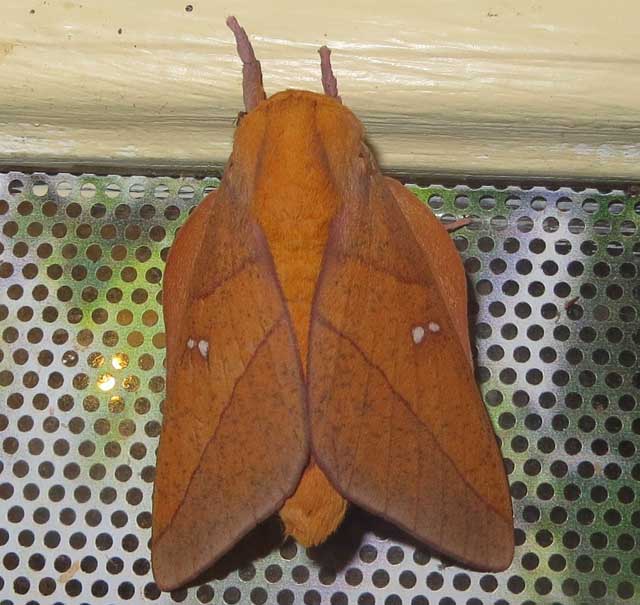Syssphinx quadrilineata occlusa
|
|
Updated as per Lemaire's Ceratocampinae 1988, September 26, 2006
Updated as per personal communication with Ryan Saint Laurent (The Smithsonian Insect Collection (USNM)); December 28, 2013
Updated as per personal communication with Brian Fletcher (Umbrellabird Lodge, Jocotoco Foundation Buenaventura Reserve, nr. Pinas, El Oro, Ecuador, February 28, 2014, 1200m); March 12, 2014
|
Syssphinx quadrilineata occlusa
SIS-sfinkzMkwah-druh-LIN-ee-ay-tuhMock-KLOO-suh
(Dognin, 1916)
Adelocephala

Syssphinx quadrilineata occlusa , Umbrellabird Lodge, Jocotoco Foundation Buenaventura Reserve,
near Pinas, El Oro, Ecuador,
February 28, 2014, 1200m, tentative id by Bill Oehlke
This site has been created by
Bill Oehlke at oehlkew@islandtelecom.com
Comments, suggestions and/or additional information are welcomed by Bill.
|
TAXONOMY:
Superfamily: Bombycoidea, Latreille, 1802
Family: Saturniidae, Boisduval, [1837] 1834
Subfamily: Ceratocampinae, Harris, 1841
was Syssphinginae: Packard, 1905
Genus: Syssphinx, Hubner [1819] 1816 |
| MIDI MUSIC
"Wonderful.World"
copyright C. Odenkirk
MIDI CITY
ON.OFF
<bgsound src="world.mid" LOOP=FOREVER>
|
DISTRIBUTION:
Syssphinx quadrilineata occlusa (wingspan: males: 59-72mm;
females: 83-90mm)
flies in
western
Colombia: Valle, Cundinamarca and Boyaca (CL)
and Santander (ARA);
western
Ecuador: Pichincha, Guayas, El Oro (BF) and probably
Esmeraldas and Manabi;
and
Venezuela.
The ground colour is orange and wings are broader than in the nominate species. White forewing discal spots may or may not be present.
The forewing pm line is broadly pre-apical.

Syssphinx quadrilineata occlusa male,
The Smithsonian Insect Collection (USNM) courtesy of Ryan St. Laurent
FLIGHT TIMES AND PREFERRED FOOD PLANTS:
Syssphinx quadrilineata occlusa
moths are on the wing in October.

Syssphinx quadrilineata occlusa female, Claude Lemaire
ECLOSION, SCENTING AND MATING:
Syssphinx quadrilineata occlusa moths tend to eclose in the evening with scenting and
mating probably occuring the same night between 10:00 pm and 2:00 am.
EGGS, LARVAE AND PUPAE:
Syssphinx
quadrilineata occlusa moth females deposit light green eggs either singly or in pairs on hostplant foliage. Eggs are translucent
and caterpillar development can be seen through the eggshell.
Warm weather results in a very short incubation time of five days. Larvae mature at various rates and have the enlarged thoracic scoli typical of Syssphinx.
Silver, metallic markings reflect light at night. Pupation is in a subterranean chamber.
Larval Food Plants
It is hoped that this alphabetical listing followed by the common name of the foodplant will prove useful. The list is not exhaustive. Experimenting with
closely related foodplants is worthwhile.
Use your browser "Back" button to return to the previous page.
Return to Syssphinx Genus
Goto South American Saturniidae Directory
Goto Main Saturniidae Index includes North America
The pronunciation of scientific names is troublesome for many. The "suggestion" at the top of the page is merely a suggestion. It is based on
commonly accepted English pronunciation of Greek names and/or some fairly well accepted "rules" for latinized scientific names.
The suggested pronunciations, on this page and on other pages, are primarily put forward to assist those who hear with internal ears as they read.
There are many collectors from different countries whose intonations and accents would be different.
The genus name "Syssphinx" was probably chosen for the similarity of these moths (wing shape and resting position) to moths in
the Sphingidae family.
The species name "quadrilineata" may refer to the four distinct lines, two on each forewing of this moth.
The subspecies name "occlusa" means 'covered' in Latin.

Syssphinx quadrilineata occlusa male, Claude Lemaire



